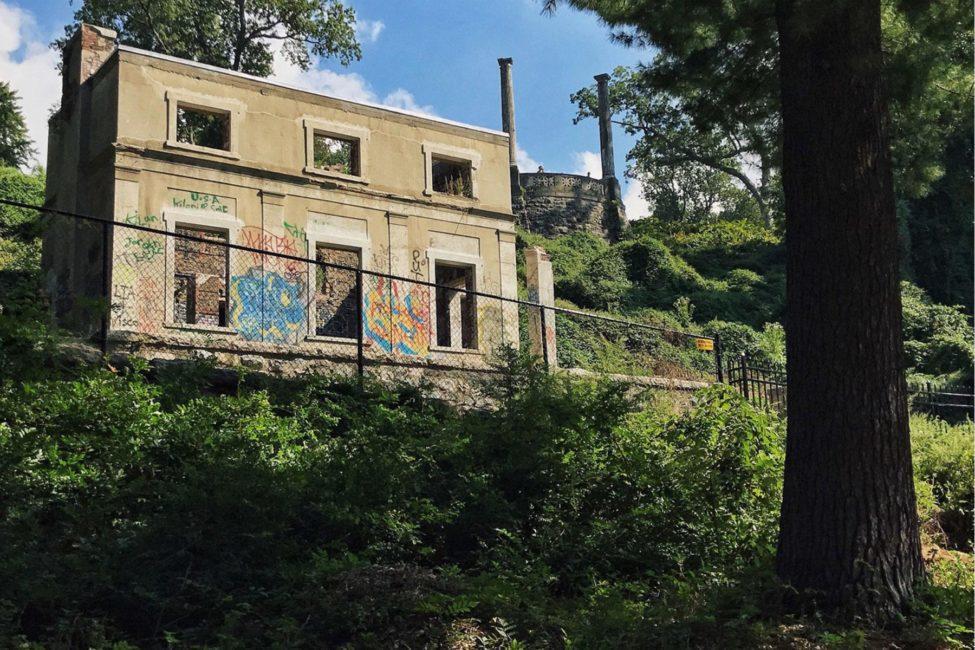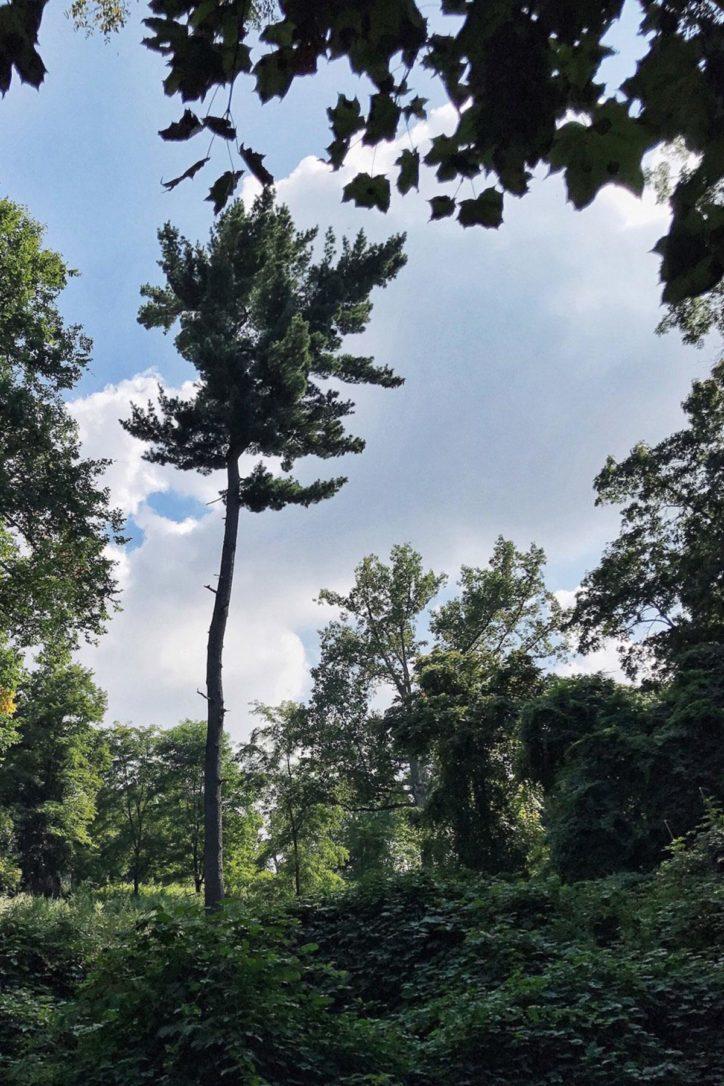How a 100-year old Gilded Age estate turned into a hotspot for Son of Sam.
At first glance, the old relic facing the Hudson River along Warburton Avenue in Yonkers seems like a gateway to nowhere. But from 1899 to 1940, this gate met visitors at the bottom of a carriage trail that twisted upward through the 171-acre estate of Samuel Untermyer. A lawyer of major wealth and renown, Untermyer lived in a three-story mansion dubbed Greystone at the trail’s end. To begin your journey through the old estate, though, you’ll have to pass by some places of malevolent beauty.

As you ascend the trail, you can just spot its outline thanks to the crumbling rock walls that pop up on either side to help. But make no mistake: this was once a grand entrance “peopled with fine old oaks, maples, hemlock, dogwood, and other forest trees.” There were even tiny flourishes like English ivy and mountain ash with orange berries planted around the walls—all signs of a horticulturalist’s touch. Untermyer, who once told a reporter he’d rather have been Parks Commissioner of New York City than a litigator, wanted his property bedazzled in flowers.
To realize his aim, he recruited star landscape architect William Welles Bosworth in 1906. Ten years later, the two had delivered a dreamscape. There was a Vegetable Garden with five separate terraces, a Color Garden with six parcels for specific hues, a Rose Garden, a Vista Garden comprised of a “thousand steps” falling for 600 feet, a Rock Garden, a Sundial Garden, and a Greek Garden with its own amphitheater walled off from the rest. When asked why’d he been so indulgent, Untermyer explained: “Such things give me the thrill of music played on a great organ!”
Recommended Fodor’s Video

Suddenly, there’s a clearing. The trail continues on ahead to a Gatehouse but first crosses a well-furrowed dirt artery. You’re on top of the Old Croton Aqueduct. A 41-mile-long tube, it carried fresh water to New York City from the Croton River between 1842 and 1955. It also made one of the most infamous cameos in city history. On May 30, 1977, as New York Daily News columnist Jimmy Breslin (1928-2017) browsed through his mail, he opened a letter:
“Hello from the gutters of N.Y.C., which are filled with dog manure, vomit, stale wine, urine, and blood. Hello from the sewers of N.Y.C. which swallow up these delicacies when they are washed away by the sweeper trucks…”
Before long, Breslin was comparing it with one that was left at a crime scene in the Bronx for Captain Joseph Borrelli back on April 17, 1977. Borrelli, a commander of the newly formed “Omega” Task Force based at the 109th Precinct in Queens, had been investigating a string of shootings across the city that involved a .44-caliber Charter Arms Bulldog revolver. Borrelli’s communique, in part, read:
“I love to hunt. Prowling the streets looking for fair game—tasty meat. The wemon [sic] of Queens are z [sic] prettyist [sic] of all. I [sic] must be the water they drink…. I am deeply hurt by your calling me a wemon [sic] hater. I am not. But I am a monster. I am the ‘Son of Sam…'”
With these letters in hand, the NYPD’s initial hunt for multiple .44-caliber suspects devolved into canvassing for a singular “.44-Caliber Killer” and, finally, the definitive lone wolf that everyone would now call “Son of Sam.” If detectives had probed the missives more deeply, though, they may have affirmed their first suspicion. Moreover, they may have realized that all the references to water—among others—pointed to this section of the Aqueduct.
When Untermyer died in 1940, he willed Greystone and its environs to the state of New York to maintain as a public park. The state demurred, however, on account of the cost of maintenance, and it was offered to the city of Yonkers instead. After years of negotiation, the city finally accepted a portion of Untermyer’s gift in 1946. Despite its best intentions, though, Yonkers couldn’t sufficiently fund the park and sold off tracts when necessary. Whittled down to 43 acres, the gardens fell into ruin as the unbridled plants overmatched the best of restoration efforts.

From the 1950s through 1970s, nature reclaimed this spot. Where once “Hans” the lion played sentinel to the two-story residence of an Untermyer maintenance man and stone stairs exposed the Color and Rose Gardens above, everything was obscured. Under wraps, the Gatehouse acquired a reputation for hosting ritualistic black masses and animal sacrifices. In fact, locals had a name for one of its back rooms: the “Devil’s Hole.” If you choose to enter, be prepared for the graffitied crosses.
If you stay outside, however, consider this. As a Yonkers patrol car passed along Warburton Avenue below in the early hours of October 6, 1978, its passenger window was blown out by the bullet from a rifle. Contemplate also the rumor about young boys having been buried in the vicinity. In 1992, someone actually confessed that he’d been ordered to dig up two bodies around 1967 and dump them in the Hudson River.

And, if you still need more to ponder, notice those huge columns to your right? They’re a short climb away. Where the Vista Garden cascades into a circular Overlook, your eyes will naturally frame out the Hudson River and New Jersey Palisades thanks to those two antique Cippolino pillars. Imported from Europe, they conclude the Vista’s homage to a walkway built at the Villa d’Este in Tivoli, Italy. A star-shaped compass is etched into the limestone floor of the terrace below. If you tap it gently, you’ll be greeted by an echo. In fact, the floor of this Overlook is really a roof. As a Yonkers historian notes, a tunnel runs under the “thousand steps” of the Vista that terminates in a chamber beneath the compass. It’s now sealed, but if you could gain access, you’d allegedly encounter “an altar…surrounded by stone chairs set in a circle.” Suggesting the possibility, a local newspaper published a photo of the Overlook in 1979 that bore this caption: “Untermyer’s ruined temple—the site of cult rituals.”
Back at the Gatehouse, you’ll barely discern a fenced off thicket to its left. In order to peer at what’s there today, you’ll need to follow the Aqueduct trail.

Less than 100 yards from the Gatehouse, a half-shorn tree reposes alone. Walking toward the tree, you’ll traverse part of the Aqueduct where a witness once spotted a wooden chair in front of a “long, wide board” nailed between two trees. In March 1979, a witness also pointed out places sprayed with the letters “NGP” that meant “Near Gutters Path.” Many friends and nearby residents referred to the Aqueduct as “the gutters” or “the sewers.” Oddly enough, the scribe of Breslin’s “Son of Sam” letter said he hailed from the “gutters” and “sewers of N.Y.C.” Other neighborhood kids further detailed “hearing animals scream in pain,” finding “at least one beheaded German shepherd,” and being “chased by two hooded figures” bearing torches here. Were these incidents connected to that “dog manure…and blood” line in the letter too?
When investigators explored it in March 1979, the Cave’s ceiling was carved up with “German SS lightning bolts” and “the numbers 666” … “inverted crosses” and “black-painted pentagrams” that surrounded a platform in the shape of an altar.
Beyond the unmistakable tree, a parking lot crests at the top of a high stone wall. According to Bosworth’s 1916 drawing of Untermyer Gardens, this was the location of the Vegetable Garden. From its peak, a stream issuing from a fountain bisected each level in a marble trough until it descended to a “pump house,” presumably to be used again. Unfortunately, this wonder was truncated when Yonkers ceded some of the park to St. John’s Hospital in 1959 and furthered eviscerated when the hospital erected its Michael Malotz Skilled Nursing Pavillon in 1999. The Pump House was a “circular structure about thirty feet in diameter that was built into the side of a hill. It was constructed of stone, and a small doorway allowed access to its dank interior.” Since many homeowners along the Aqueduct often tapped into its water supply in the early 1900s, Untermyer probably did as well to bring the fountain in his Vegetable Garden to life. His access point was likely kept secret even after the Aqueduct was decommissioned. Unfortunately, the park’s long decades of disuse also buried the Pump House in brush and infamy. Like the Gatehouse, it was given a nickname: the “Devil’s Cave.”
When investigators explored it in March 1979, the Cave’s ceiling was carved up with “German SS lightning bolts” and “the numbers 666.” One wall was covered with “inverted crosses” and “black-painted pentagrams” that surrounded a platform in the shape of an altar. Among the paintings of Satan, they also jolted at the sight of a black “X-shaped figure with arrow points at the four ends.” The “Son of Sam” signed his message to Breslin with the exact same symbol.
Outside the Cave, “small red arrows painted on a series of trees” marked a path up to St. John’s parking lot. Today, a tattered oxblood fence leading away from the site is adorned with triangles in spots—perhaps an update of those previous markings. In the late 1970s, though, the path was pernicious. When a teenage girl happened upon it, she unwittingly interrupted a meeting in the Cave and was raped. On Halloween 1978, some student nurses and doctors at St. John’s alerted police after they heard “chanting” and spotted “candles and torches” below. Security guards saw people in hoods. When the cops arrived, the group was gone, but it left behind a gray “hood and two capes.” Further reports of an exorcism “performed on the Pump House walls” and “twelve people…between ages 20-40 eating brownies and chanting around a candlelit table” left observers exasperated. What was happening in the Cave? The answer was chilling.

Two weeks before David Berkowitz was arrested for the “Son of Sam” shootings, he authored a letter the NYPD would recover from his apartment but not release to the public. On July 29, 1977, less than a mile south down the Aqueduct trail from Untermyer Gardens, Berkowitz penned from 35 Pine Street:
This is a warning to all police agencies in the tri-state area: For your information, a satanic cult (devil worshipers and practitioners of witchcraft) that has been established for quite some time has been instructed by their high command (Satan) to begin to systematically kill and slaughter young girls or people of good health and clean blood. They plan to kill at least 100 young wemon [sic] and men, but mostly wemon, as part of a satanic ritual which involves the shedding of the victims’ innocent blood…”
Untermyer had become the cult’s fulcrum. During Berkowitz’s 15-month residency on Pine Street, the group was quite active in the neighborhood: two houses were firebombed, one family’s German shepherd was killed and another’s injured in drive-by shootings, two shepherds were found strangled in plastic bags and one shot along the Aqueduct trail, trash in front of the apartment below Berkowitz’s was set ablaze and, finally, the mailman was driven to suicide.
In 1993, Berkowitz finally admitted to being “initiated” into the cult at Untermyer Gardens in the spring of 1975. But yet, here—standing less than 100 yards from the Gatehouse—you’ll only detect deer rustling about, birds quarreling, and maybe a kid racing past you on a mountain bike who abruptly disappears. It’s time to see the rest of the park. The Devil’s Cave is gone. The only hint of such a thing’s former whereabouts are the two pieces of rebar a neighbor has fashioned into a familiar symbol: it’s anchored to that tree stump behind you.





